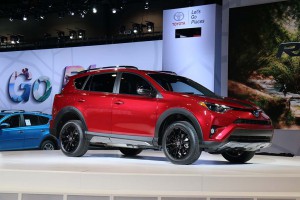Automakers that make attractive, high-quality sport-utility vehicles are more likely to get the repeat buyers that are so important dealer and company bottom lines, according to a new study.
On the surface, that may not sound like news, but the shift away from passenger cars to sport-utes in the wake of the 2008 recession shows that buyer’s are loyal to automakers that provide quality people movers that are consistently improved.
The results come from the 2018 Edmunds Trade-In Loyalty Report, which examines information collected from 13.9 million vehicle transactions from 2007 to 2017. Bottom line: when automakers made better SUVs, people move to them repeatedly.
“There’s been a dramatic shift in the last 10 years in the tastes of car buyers, and with auto sales on the decline, maintaining customer loyalty has arguably never been more important,” said Jessica Caldwell, executive director of industry analysis at Edmunds. “Trade-in customers are a critical group for automakers to keep in the brand family, as in theory they should be among the easiest to retain.”
(Toyota reveals track-bound Supra concept. Click Here for the story.)
More importantly, it’s clear that quality is important to buyers, repeat buyers, which are the least expensive — from an advertising and marketing cost perspective — buyers to corral.
According to the report, the reputation Toyota and Honda have for quality and reliability keep buyers coming back to the brand. Even though this reputation was built on the backs of passenger cars, it has successfully transferred to the companies’ SUV portfolios.
Subaru owes its success primarily to offering the right products at the right time: thanks to making a quick pivot to a lineup bolstered by desirable SUVs, the brand has seen its loyalty leap from 45% in 2007 to 61% in 2017.
Lexus, Audi and Land Rover lead in the luxury loyalty, but that favoritism is slipping. These buyers are typically less loyal normally, but the drop has been precipitous lately. It’s been dropping steadily for the last three years, hitting 37% last year, the lowest since 2009.
Similar to its twin brand on the mainstream side, Lexus earned the luxury loyalty crown by appealing to practical buyers who embrace the brand’s reputation for comfort and reliability, Edmunds noted. Audi came in second place by leveraging the opposite strategy and focusing on appealing to buyer emotions with distinct designs and a focus on performance.
(Click Here to see what automakers dominated the Consumer Reports top 10 cars list.)
Similar to Subaru on the mainstream side, Land Rover’s SUV-heavy lineup is perfectly in line with current consumer tastes, and the brand doesn’t have the baggage of displaced former passenger car owners weighing them down.
The market place has seen dramatic changes during the decade the study covers, including the implementation of lower and lower CAFE mandates, dramatic swings in fuel prices and the economic climate converged, forcing automakers to change how they approached the SUV segment.
At the beginning of the 10-year period SUVs were “boxy gas guzzlers” and automaker went to work improving mileage. As gas prices came down, their popularity soared making them “family haulers.” In 2017, SUVs dethroned trucks in buyer loyalty for the first time, and passenger vehicle loyalty hit a low not seen since 2009.
Edmunds analysts predict that by the end of 2018, passenger car loyalty could drop so low that it would match the loyalty level for SUVs during the Cash for Clunkers period, a drop of 15 percent in just 10 years.
“We’re heading into one of the most transformative periods in the automotive industry, and instability in the short term could severely jeopardize automaker success further down the line,” said Caldwell.
(To see more about Subaru’s sales goals, Click Here.)
“Sales are cooling off from record highs, and the abundance of offerings on the market has created a new reality where nameplate loyalty no longer holds the same weight. It’s going to be a delicate balance for automakers as they face the immediate challenge of keeping customers in the fold while also anticipating the demands of the future.”

